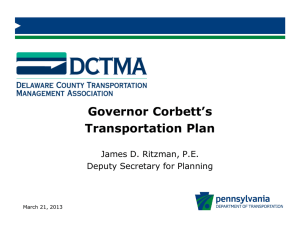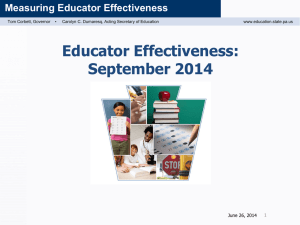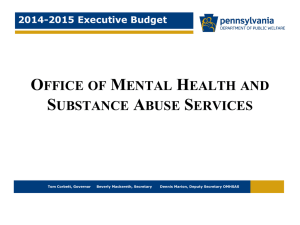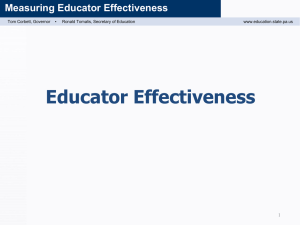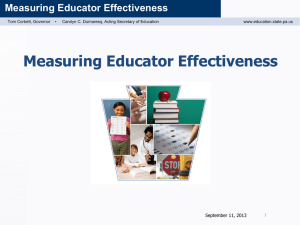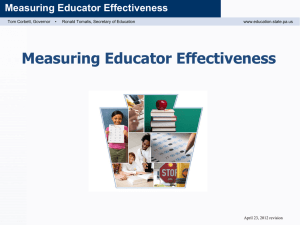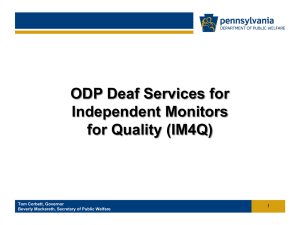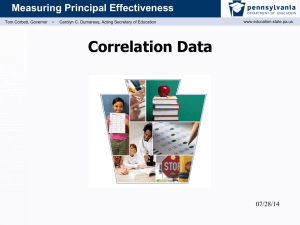Measuring Principal Effectiveness
advertisement
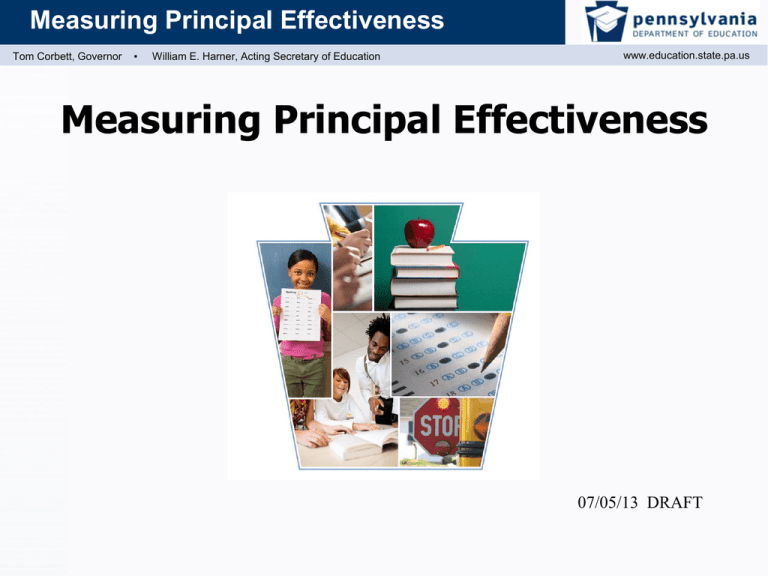
Measuring Principal Effectiveness Tom Corbett, Governor ▪ William E. Harner, Acting Secretary of Education www.education.state.pa.us Measuring Principal Effectiveness 07/05/13 DRAFT Measuring Principal Effectiveness Tom Corbett, Governor ▪ William E. Harner, Acting Secretary of Education www.education.state.pa.us Principal Effectiveness Why Important and Why Now? • Effective school leadership has an impact on developing a culture focused on student achievement. As noted in the Wallace Foundation report: “The School Principal as Leader”: – “They [principals] have to be leaders of learning who can develop a team to deliver effective instruction.” • Given Act 82, we are able to develop a Framework for Leadership in tandem with the deployment of the Danielson Framework for Teaching. 2 Measuring Principal Effectiveness Tom Corbett, Governor ▪ William E. Harner, Acting Secretary of Education www.education.state.pa.us Principal Effectiveness Why Important and Why Now? (continued) • Focusing on leadership and teaching frameworks concurrently enables schools more opportunities to enhance student achievement and promote collaboration. • As the Commonwealth continues its work with the establishment of universal effectiveness frameworks, it is essential that building and system leaders have initial and ongoing training to guarantee sustainability and reliability. 3 Measuring Principal Effectiveness Tom Corbett, Governor ▪ William E. Harner, Acting Secretary of Education www.education.state.pa.us Developing a Framework: Our Journey Framework for Leadership Review of Research and Other Experts Consulted 4 Measuring Principal Effectiveness Tom Corbett, Governor ▪ William E. Harner, Acting Secretary of Education www.education.state.pa.us Developing a Framework: Our Journey Review of Existing Work From Other States / Act 45 – Core and Corollary Standards • Reviewed existing state models from North Carolina, Delaware, Washington, Tennessee, Kentucky and Colorado. • Analyzed elements of the various models from the following perspectives: • The nine PA School Leadership Standards; Specifically the Core & Corollary Leadership Standards as mandated by Act 45 of 2007. • The leader’s role in improving student achievement. • The desire for measureable and constructive feedback to staff. 5 Measuring Principal Effectiveness Tom Corbett, Governor ▪ William E. Harner, Acting Secretary of Education www.education.state.pa.us Developing a Framework: Our Journey Review of Research and Other Experts Consulted Research • Measures of Effective Teaching (MET) Experts • Mid-Atlantic Regional Education Lab (REL) • RAND Corporation Report: “First • Mathematica Year Principals in Urban School • Technical Advisory Committee Districts” (TAC) • Wallace Foundation Report: “The • American Institute of Research School Principal as Leader” (AIR) – Matt Clifford • April 2010 Policy Brief, Center for • Stakeholders (superintendents and Analysis of Longitudinal Data in principals) representing LEAs of Education Research (CALDER) various sizes and locations throughout the Commonwealth. 6 Measuring Principal Effectiveness Tom Corbett, Governor ▪ William E. Harner, Acting Secretary of Education www.education.state.pa.us Developing a Framework: Our Journey Conducting Pilot Phases Various phases have been implemented to pilot the Framework for Leadership and additional supporting materials. Obtaining direct feedback from the field during each of these phases has been a critical piece. • Phase I (2011 – 12) – Feedback from a mini pilot indicated the need to develop a more robust framework and provide supporting resources. 7 Measuring Principal Effectiveness Tom Corbett, Governor ▪ William E. Harner, Acting Secretary of Education www.education.state.pa.us Developing a Framework: Our Journey Conducting Pilot Phases (continued) • Phase II (2012 – 13) – Included 194 LEAs (districts, career and technical centers, charter schools). – 1,982 principals participated. – Surveys used to obtain qualitative feedback to inform Phase III (process, structure of Framework, resources, etc.). – Quantitative research is being conducted by Mathematica (through the Mid-Atlantic REL) to validate the Framework for Leadership. 8 Measuring Principal Effectiveness Tom Corbett, Governor ▪ William E. Harner, Acting Secretary of Education www.education.state.pa.us Developing a Framework: Our Journey Conducting Pilot Phases (continued) • Phase III (2013 – 14) – Feedback from Phase II participants has resulted in the following enhancements being implemented for Phase III: • Inclusion of a new component 2g to the Framework for Leadership: Ensures a High Quality, High Performing Staff. • Updates to documents that outline Types of Evidence that can be used to inform the process. • Creation of a Connectedness document provides a focus on the relationship between the Framework for Leadership and the Danielson Framework for Teaching. • Creation of documents that include Possible Guiding Questions for strategic discussions among various stakeholders. • Updated process for implementation of Phase III. 9 Measuring Principal Effectiveness Tom Corbett, Governor ▪ William E. Harner, Acting Secretary of Education www.education.state.pa.us Framework for Leadership Incorporating Act 82 of 2012 • Within Act 82, new requirements for Educator Effectiveness have been defined for teachers, principals, and education specialists. Specific to the principal are the evaluation categories of Planning and Preparation, School Environment, Delivery of Service, and Professional Development. • Utilizing the expertise previously identified, a Framework for Leadership was developed with a defined domain and component structure. An alignment of this framework structure to the Act 82 legislated categories was completed. 10 Measuring Principal Effectiveness Tom Corbett, Governor ▪ William E. Harner, Acting Secretary of Education www.education.state.pa.us Framework for Leadership Alignment with Act 82 11 Measuring Principal Effectiveness Tom Corbett, Governor ▪ William E. Harner, Acting Secretary of Education www.education.state.pa.us Framework for Leadership Domains • The Framework for Leadership establishes a set of four leadership domains: • • • • Domain 1: Strategic/Cultural Leadership Domain 2: Systems Leadership Domain 3: Leadership for Learning Domain 4: Professional and Community Leadership • The Framework for Leadership contains specific components (with corresponding descriptors) to be included in each of the four domains. 12 Measuring Principal Effectiveness Tom Corbett, Governor ▪ William E. Harner, Acting Secretary of Education www.education.state.pa.us Domain 1: Strategic/Cultural Leadership With Components Domain Descriptor: The school leader will systematically and collaboratively develop a positive culture to promote continuous student growth and staff development. The leader articulates and models a clear vision of the school’s culture that involves students, families, and staff. Components Included in Domain: – Creates an Organizational Vision, Mission, and Strategic Goals – Uses Data for Informed Decision Making – Builds a Collaborative and Empowering Work Environment – Leads Change Efforts for Continuous Improvement – Celebrates Accomplishments and Acknowledges Failures 13 Measuring Principal Effectiveness Tom Corbett, Governor ▪ William E. Harner, Acting Secretary of Education www.education.state.pa.us 14 Measuring Principal Effectiveness Tom Corbett, Governor ▪ William E. Harner, Acting Secretary of Education www.education.state.pa.us Domain 2: Systems Leadership With Components Domain Descriptor: The school leader will ensure that the school has processes and systems in place for budgeting, staffing, problem solving, communicating expectations and scheduling that result in organizing the work routines in the building. The school leader must efficiently, effectively, and safely manage the building to foster staff accountability and student achievement. Components Included in Domain: – Leverages Human and Financial Resources – Ensures School Safety – Complies with Federal, State, and LEA Mandates – Establishes and Implements Expectations for Students and Staff – Communicates Effectively and Strategically – Manages Conflict Constructively – Ensures a High Quality, High Performing Staff (added for Phase III) 15 Measuring Principal Effectiveness Tom Corbett, Governor ▪ William E. Harner, Acting Secretary of Education www.education.state.pa.us Domain 3: Leadership for Learning With Components Domain Descriptor: The school leader assures a Standards Aligned System is in place to address the linkage of curriculum, instruction, assessment, and data on student learning and teacher effectiveness based on research and best practices. Components Included in Domain: – Leads School Improvement Initiatives – Aligns Curricula, Instruction, and Assessments – Implements High Quality Instruction – Sets High Expectations for All Students – Maximizes Instructional Time 16 Measuring Principal Effectiveness Tom Corbett, Governor ▪ William E. Harner, Acting Secretary of Education www.education.state.pa.us Domain 4: Professional and Community Leadership With Components Domain Descriptor: The school leader promotes the success of all students, the positive interactions among building stakeholders, and the professional growth of staff by acting with integrity, fairness and in an ethical manner. Components Included in Domain: – Maximizes Parent and Community Involvement and Outreach – Shows Professionalism – Supports Professional Growth 17 Measuring Principal Effectiveness Tom Corbett, Governor ▪ William E. Harner, Acting Secretary of Education www.education.state.pa.us Data Requirements for Phase III 2013-14 School Year • Quantitative Research Supervising Administrators will submit ratings for components evaluated (minimum of 2 components per domain). – Data is submitted to researchers.- NOT PDE. – PDE only receives aggregate results from the researchers (no individualized results). – Supporting evidence and/or other documentation used to inform the evaluation process should NOT be submitted (local use only). • Qualitative Research A survey will be sent after Phase III to obtain feedback on process and supporting resources (to be reviewed by the principal leadership team). 18 Measuring Principal Effectiveness Tom Corbett, Governor ▪ William E. Harner, Acting Secretary of Education www.education.state.pa.us Multiple Measures Principal Effectiveness Ratings as Defined in Act 82 • For the overall principal effectiveness rating, we know that… – 50% will comprise the practice piece (Framework for Leadership). – 15% will be derived by the School Performance Profile. – 15% will be determined by a relationship between teacher PVAAS scores and teacher Danielson ratings (for those teachers with eligible PVAAS scores). – 20% will be developed using a wide range of indicators (Elective Data – SLOs for principals). 19 Measuring Educator Effectiveness Tom Corbett, Governor ▪ William E. Harner, Acting Secretary of Education www.education.state.pa.us Principal Effectiveness System in Act 82 of 2012 Effective 2014-2015 SY Observation/ Evidence Framework for Leadership Domains 1. Strategic/Cultural Leadership 2. Systems Leadership 3. Leadership for Learning 4. Professional and Community Leadership Building Level Data, 15% Observation / Evidence 50% Building Level Data/School Performance Profile Indicators of Academic Achievement Indicators of Closing the Achievement Gap, All Students Indicators of Closing the Achievement Gap, Subgroups Academic Growth PVAAS Other Academic Indicators Credit for Advanced Achievement Correlation between Teacher PVAAS scores and Teacher Danielson rating 15% Elective Data 20% Correlation/Relationship based on Teacher Level Measures PVAAS Elective Data/SLOs District Designed Measures and Examinations Nationally Recognized Standardized Tests Industry Certification Examinations Student Projects Pursuant to Local Requirements Student Portfolios Pursuant to Local Requirements Measuring Principal Effectiveness Tom Corbett, Governor ▪ William E. Harner, Acting Secretary of Education www.education.state.pa.us Rating Tool Starting in the 2014-15 School Year • A rating tool will be developed that incorporates all aspects of the Principal Effectiveness System such that a final rating for a principal can be determined. • Final ratings and all supporting evidence/documentation for individuals will be kept at the local level. Only aggregate ratings information will be submitted to PDE. • The rating tool will reflect a similar design as the one developed for teacher evaluation. 21 Measuring Principal Effectiveness Tom Corbett, Governor ▪ William E. Harner, Acting Secretary of Education www.education.state.pa.us Alignment with PIL Possible Approaches • Following the completion of initial training on the Danielson Framework for Teaching and certification for inter-rater reliability, principals will receive reinforcement of these concepts within the PIL program. • Incorporate teacher evaluation information into NISL Course 1 (part of Principal Induction). – Currently PIL Induction participants must complete an Administrative Leadership Project (ALP). – As the ALP must be focused on improving student achievement, we would require that participants connect their individual ALP back to a specific domains in the evaluation tool. – Potential of creating a Professional Learning Community for the participants through SAS. 22 Measuring Principal Effectiveness Tom Corbett, Governor ▪ William E. Harner, Acting Secretary of Education www.education.state.pa.us Alignment with PIL Possible Approaches • Incorporate training on the Framework for Leadership into Course 1, Unit 3 (Principal Induction) where participants must focus on the elements of Standards-Based Instructional Systems, as found on SAS. • Incorporate training on the Framework for Leadership into Course 1, Unit 4 (Principal Induction) where participants could actually focus on the use of the framework in each of the domains. 23 Measuring Principal Effectiveness Tom Corbett, Governor ▪ William E. Harner, Acting Secretary of Education www.education.state.pa.us Principal Effectiveness Instrument Alignment with Act 82 and PIL Program 24 Measuring Principal Effectiveness Tom Corbett, Governor ▪ William E. Harner, Acting Secretary of Education www.education.state.pa.us A Look Ahead… Additional Work to be Completed • Providing Professional Development modules for inclusion on SAS. • Developing train-the-trainer programs that will provide principals with a global perspective on SLOs and how they can be used collectively by the staff in promoting student achievement. • Looking at developing cohorts for principals in priority & focus schools: – Cohorts would participate in specialized in-service opportunities offered through PIL program. – Programs would address achievement and barriers within the current delivery system. 25 Measuring Principal Effectiveness Tom Corbett, Governor ▪ William E. Harner, Acting Secretary of Education www.education.state.pa.us PDE Workgroup Next Steps: Timeline - update • Dialogue with Stakeholders: Ongoing • Train-the-Trainer (Refresher Training) for IUs: July 23 • IUs deliver regional turn-around training for central office administrators and principals: August 2013 – November 2013 • Offer principal effectiveness sessions at SAS Institute: December 8 - 11, 2013 • Deploy Phase III of Principal Effectiveness Project: November 2013 – June 2014 26 Measuring Principal Effectiveness Tom Corbett, Governor ▪ William E. Harner, Acting Secretary of Education www.education.state.pa.us The mission of the Pennsylvania Department of Education is to lead and serve the educational community, to enable each individual to grow into an inspired, productive, fulfilled lifelong learner. 27
